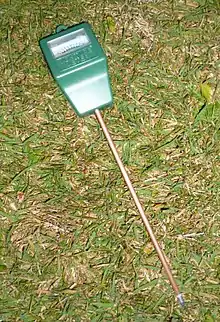
Soil moisture sensors measure the volumetric water content in soil.[1] Since the direct gravimetric measurement of free soil moisture requires removing, drying, and weighing of a sample, soil moisture sensors measure the volumetric water content indirectly by using some other property of the soil, such as electrical resistance, dielectric constant, or interaction with neutrons, as a proxy for the moisture content.
The relation between the measured property and soil moisture must be calibrated and may vary depending on environmental factors such as soil type, temperature, or electric conductivity. Reflected microwave radiation is affected by the soil moisture and is used for remote sensing in hydrology and agriculture. Portable probe instruments can be used by farmers or gardeners.
Soil moisture sensors typically refer to sensors that estimate volumetric water content. Another class of sensors measure another property of moisture in soils called water potential; these sensors are usually referred to as soil water potential sensors and include tensiometers and gypsum blocks.
Technology
Technologies commonly used to indirectly measure volumetric water content (soil moisture) include:
- Frequency Domain Reflectometry (FDR): The dielectric constant of a certain volume element around the sensor is obtained by measuring the operating frequency of an oscillating circuit.
- Time Domain Transmission (TDT) and Time Domain Reflectometry (TDR): The dielectric constant of a certain volume element around the sensor is obtained by measuring the speed of propagation along a buried transmission line;[2] (see also: TDR moisture sensor)
- Neutron moisture gauges: The moderator properties of water for neutrons are utilized to estimate soil moisture content between a source and detector probe.
- Soil resistivity: Measuring how strongly the soil resists the flow of electricity between two electrodes can be used to determine the soil moisture content.
- Galvanic cell: The amount of water present can be determined based on the voltage the soil produces because water acts as an electrolyte and produces electricity. The technology behind this concept is the galvanic cell.[3]
Application
Agriculture
Measuring soil moisture is important for agricultural applications to help farmers manage their irrigation systems more efficiently. Knowing the exact soil moisture conditions on their fields, not only are farmers able to generally use less water to grow a crop, they are also able to increase yields and the quality of the crop by improved management of soil moisture during critical plant growth stages.
Landscape irrigation
In urban and suburban areas, landscapes and residential lawns are using soil moisture sensors to interface with an irrigation controller. Connecting a soil moisture sensor to a simple irrigation clock will convert it into a "smart" irrigation controller that prevents irrigation cycles when the soil is already wet, e.g. following a recent rainfall event. [4]
Golf courses are using soil moisture sensors to increase the efficiency of their irrigation systems to prevent over-watering and leaching of fertilizers and other chemicals into the ground.
Research
Soil moisture sensors are used in numerous research applications, e.g. in agricultural science and horticulture including irrigation planning, climate research, or environmental science including solute transport studies and as auxiliary sensors for soil respiration measurements.[5]
Simple sensors for gardeners
Relatively cheap and simple devices that do not require a power source are available for checking whether plants have sufficient moisture to thrive. After inserting a probe into the soil for approximately 60 seconds, a meter indicates if the soil is too dry, moist or wet for plants.
See also
References
- ↑ Arnold, James E. "Soil Moisture". NASA. Retrieved 15 June 2015.
Soil moisture is difficult to define it means different things in different disciplines. For example, a farmer's concept of soil moisture is different from that of a water resource manager or a weather forecaster. Generally, however, soil moisture is the water that is held in the spaces between soil particles. Surface soil moisture is the water that is in the upper 10 cm of soil, whereas root zone soil moisture is the water that is available to plants, which is generally considered to be in the upper 200 cm of soil.
- ↑ Blonquist, J. M. (April 2005). "A time domain transmission sensor with TDR performance characteristics" (PDF). Journal of Hydrology. 314 (1–4): 235–245. Bibcode:2005JHyd..314..235B. doi:10.1016/j.jhydrol.2005.04.005. Archived (PDF) from the original on 19 October 2016. Retrieved 31 Jan 2016.
- ↑ Gaikwad, Pramod (2015). "Galvanic Cell Type Sensor for Soil Moisture Analysis". Analytical Chemistry. 87 (14): 7439–7445. doi:10.1021/acs.analchem.5b01653. PMID 26098202.
- ↑ Kevin Handreck. Good Gardens with Less Water, Csiro Publishing, 2008 ISBN 0643094709 pages 79-81
- ↑ Decagon Devices "List of peer-reviewed publications using Decagon soil moisture sensors Archived 2016-03-04 at the Wayback Machine". Retrieved: 20 July 2015.
External links
- Wessel-Bothe, Weihermüller (2020): Field Measurement Methods in Soil Science New practical guide to soil measurements explains the principles of operation of different moisture sensor types (independent of manufacturer), their accuracy, fields of application and how such sensors are installed, as well as subtleties of the data so obtained. Also deals with other crop-related soil parameters.
- The Soil Water Compendium (soil water content sensors explained)
- Irrigation Monitoring with Soil Water Sensors
- Practical Overview of Soil Moisture in 2010
- When2Water Sensors Tutorials about using sensors and tensiometers in irrigation scheduling